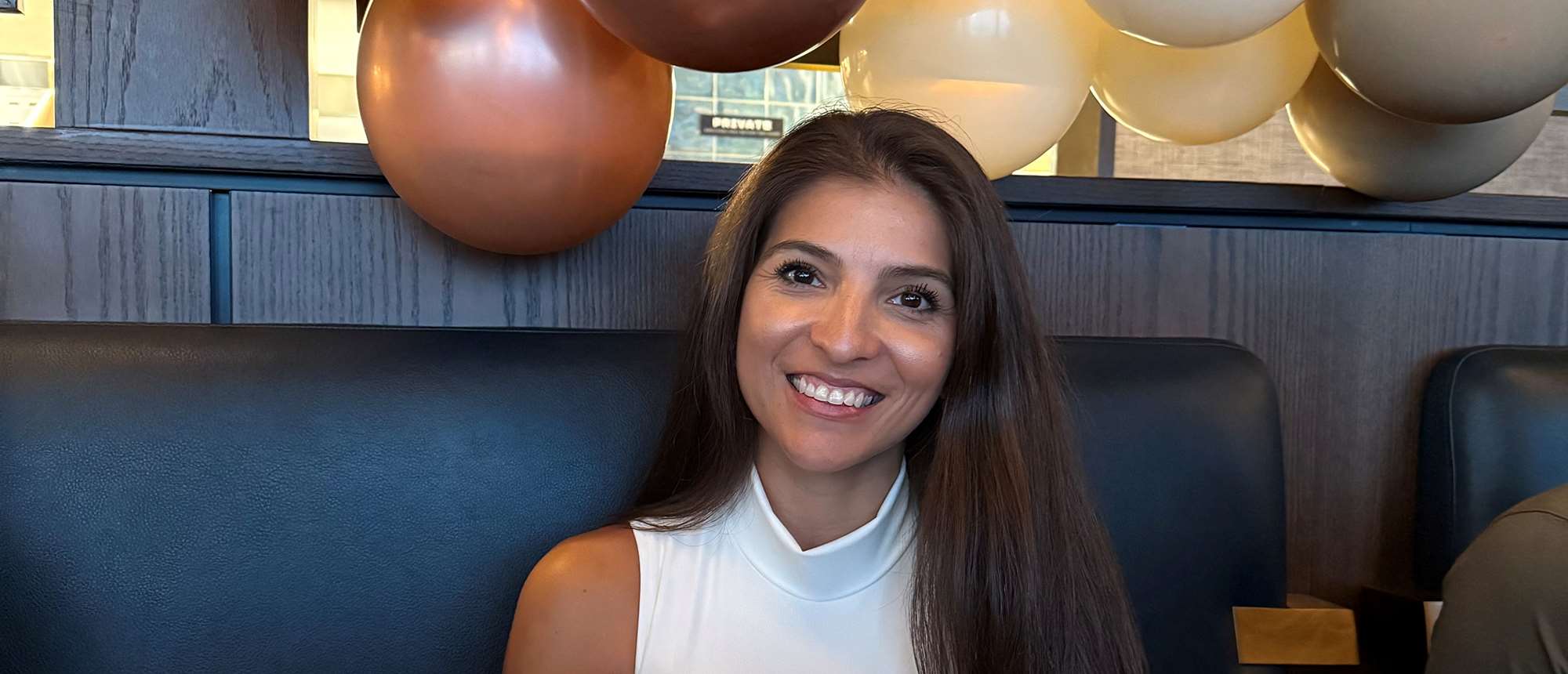We Remember a Visionary: The Legacy of T. Michael Bolger – Part 2
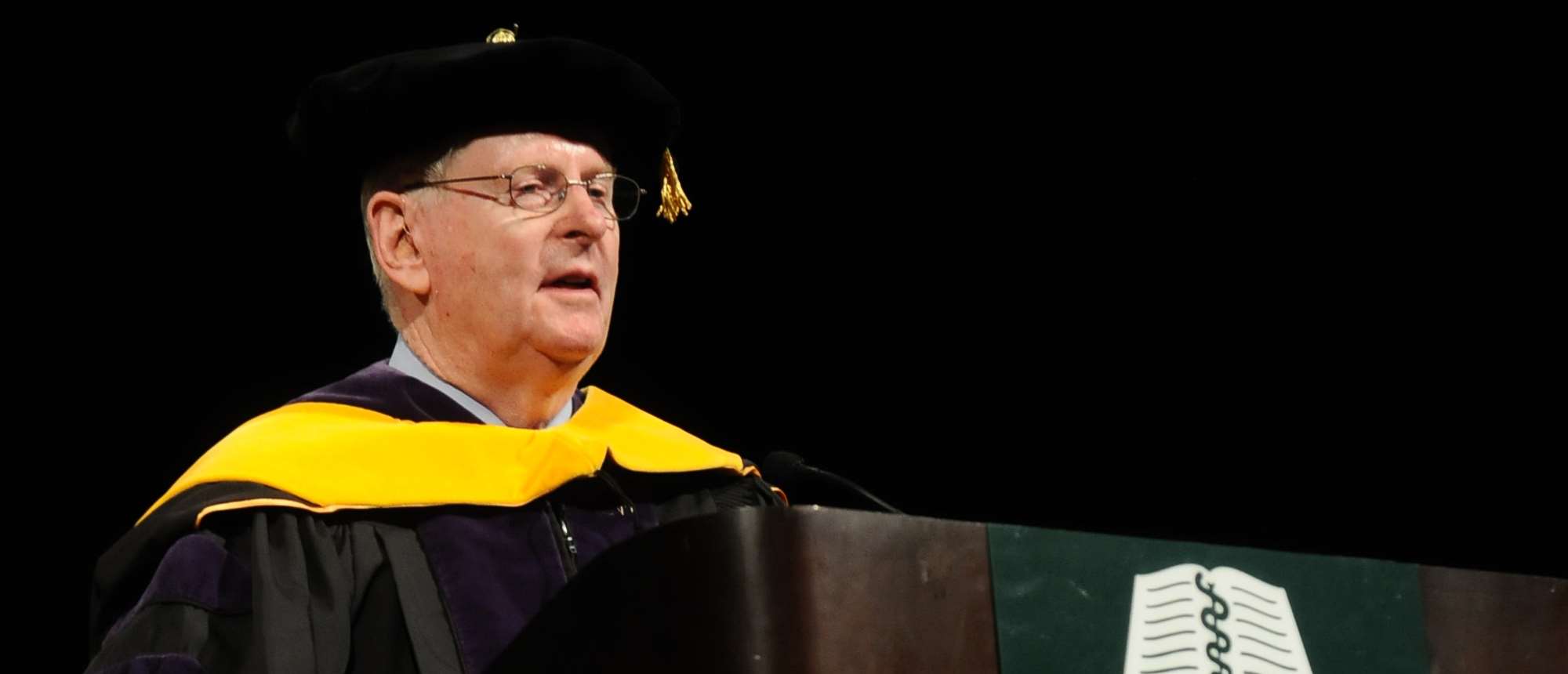
The Spring 2019 issue of MCW Magazine features a tribute to T. Michael Bolger (1939-2018), the longest-serving president and CEO of the Medical College of Wisconsin. This is the second installment in a three-part series about his remarkable life and legacy. In the fall of 2016, Mike sat down with MCW’s chief historian, Richard (Dick) Katschke, to record his memories. Mike’s words are interspersed throughout the story in italicized font.
1990: MCW presidency begins
In 1990, an unexpected opportunity presented itself to Mike to join MCW as its fifth president.
Ed Lennon [Edward J. Lennon, MD, MCW dean from 1978-1985 and president from 1984-1990] needed to step down due to health issues. I was surprised when my name came up as a possible successor since I had been the legal counsel for 20 years. A number of faculty members asked me to consider submitting my name for consideration. I asked them, “Why I should do that?” After all, I was a senior partner in a big law firm. They began to talk about the opportunity to take care of the poor, educate the next generation of healthcare professionals – in other words, they were pushing those old Jesuit hot buttons of mine. Buz Cooper [Richard A. Cooper, MD, dean from 1985-1994] thought it would be a good idea to get a non-MD as the president, so he supported my nomination. I think that was the tipping point. I told the board when they offered me the position that I would stay on the job for five years, and then go back to my law practice. Five years stretched into 20, and I had a wonderful run.
Mike spoke at great length with his wife, Ginny, about accepting the presidency. “He convinced me by saying it would be easier than being a lawyer,” Ginny recalls with a smile. “His goal was to ensure that MCW was well known in the community, and he put this plan into place by going out to a different dinner every night for the first few years to make a presentation. Everyone liked Mike and trusted him. He really wanted to ensure that top-tier healthcare existed in the Milwaukee area,” she adds.
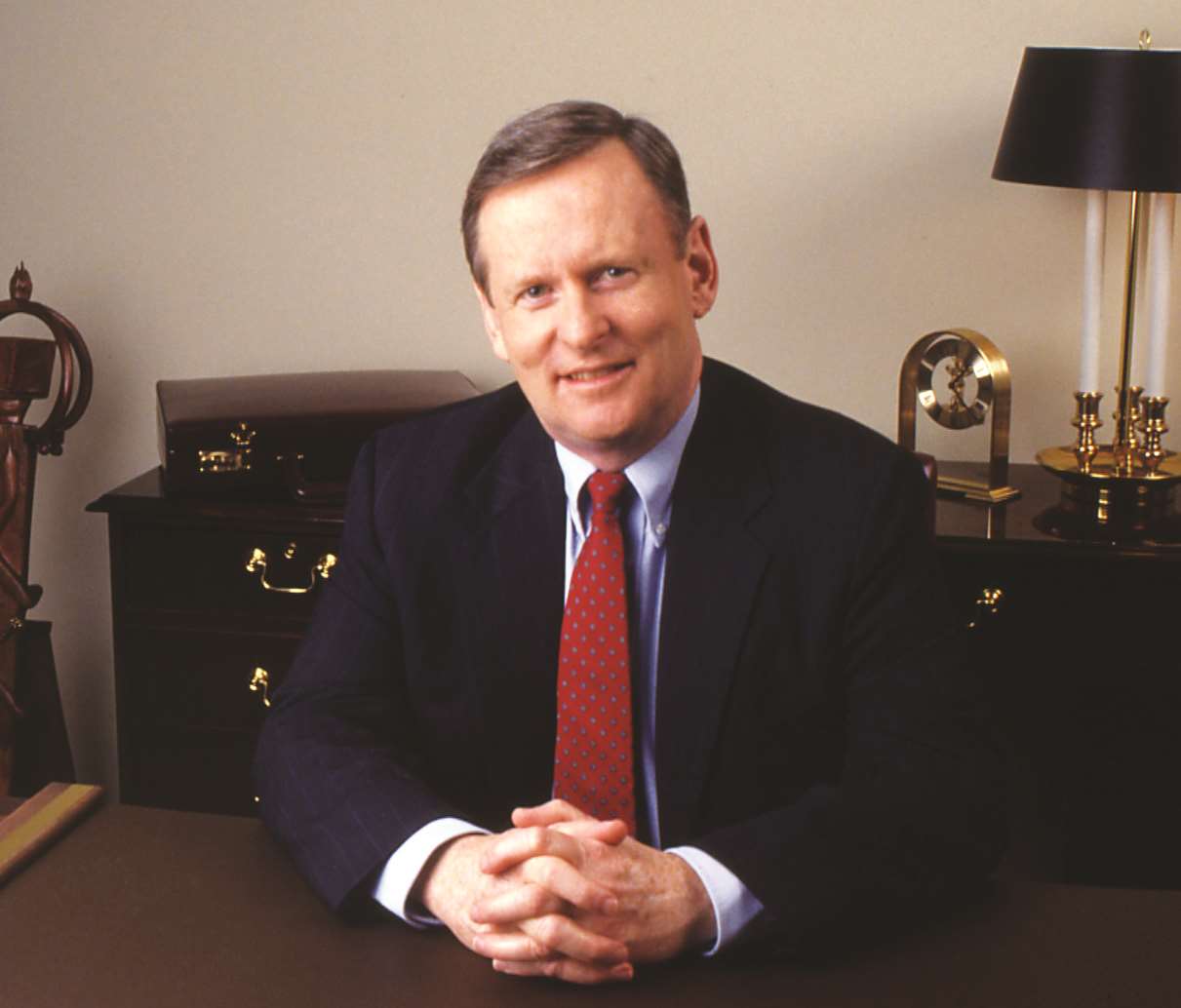
I wanted to make this one of the best medical schools in the country. I went around the country to talk to my peers to understand what separates the best medical schools from the also-rans. To a person, they all said it was the quality and quantity of their research. So I wanted to play that game as well, and being a lawyer, I wanted to win. I had to fight the board to do that, because you lose money when you do research. I bet my presidency on building up the research along with the educational side, and Dr. Cooper was my advocate on this. We worked very closely on this, and then with Dr. Dunn [Michael J. Dunn, MD, dean of the MCW School of Medicine from 1995-2008] later on. I also made a point of meeting regularly with elected officials, both local and statewide. I would report to them what we were doing and let them know we would appreciate their help. I would fly to Washington every month to meet with our legislative delegation. We had a good working relationship with government officials.
Reengaging with alumni
Another one of Mike’s top goals was to reconnect with and reengage the alumni – many of whom blamed the medical school for the separation from Marquette in 1967. The alumni were so incensed that they broke away from the medical school entirely and formed their own association.
I was shocked to learn that the Alumni Association was a separate corporation from the medical school, and you had to pay dues to be a member. I started by taking the most outspoken critics of the medical school to dinner every Tuesday night to a dinner I hosted at the University Club, and I invited the best members of our faculty to mingle with the severest critics. The alumni were very angry about the separation from Marquette. They saw that I didn’t have an ax to grind because at one point I had been the president of the Marquette Alumni Association. I bought out the Association’s administrator and made the Alumni Association a non-dues paying organization. Slowly but surely, the critics came around. The board even created one slot that always would be filled by an alumnus selected by the Alumni Association.
Mike’s success in bringing the alumni back in the fold made a huge impact on Ginny. “After about five years of interaction with Mike, the older alumni began to request second diplomas that featured the MCW logo,” she recalls. Visiting alumni around the country was an important strategy of Mike’s to cement ties with the medical school. “We would start traveling at the end of January to meet with alumni, and by spring we would return to drive around the state to meet the locals,” Ginny remarks. Today there are more than 18,000 members of the MCW/Marquette Medical Alumni Association located throughout the world.
Growth in research spurs new buildings
Under Mike’s leadership, MCW experienced tremendous growth in its research enterprise and rose into the top third of all US medical schools for federal research grants. Also during that time, approximately $200 million in new MCW buildings were constructed on the MRMC campus to support the research mission.
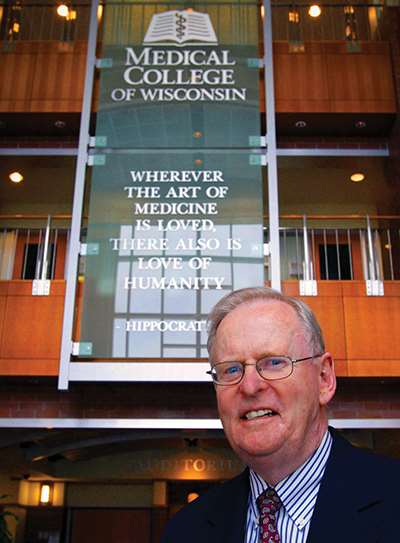 On the theory that if you build it, they will come…when I first came here, I talked with Ron Cornelius, our COO, and told him I wanted to increase our footprint for research. He told me that when the MEB was built, it was built to hold four floors, but we only built three. So we could build that fourth floor pretty quickly and easily, which would add 65,000 square feet for research. It took only nine months to add that fourth floor for research. That whetted my appetite, and I met with Les Aspin [Leslie Aspin, Jr., US Representative from 1971-1993 and US Secretary of Defense from 1993-1994], who at that time was head of the Armed Service Committee in Congress. I asked him to earmark $14 million from the Department of Defense budget to build a new research center, which he gave to us.
On the theory that if you build it, they will come…when I first came here, I talked with Ron Cornelius, our COO, and told him I wanted to increase our footprint for research. He told me that when the MEB was built, it was built to hold four floors, but we only built three. So we could build that fourth floor pretty quickly and easily, which would add 65,000 square feet for research. It took only nine months to add that fourth floor for research. That whetted my appetite, and I met with Les Aspin [Leslie Aspin, Jr., US Representative from 1971-1993 and US Secretary of Defense from 1993-1994], who at that time was head of the Armed Service Committee in Congress. I asked him to earmark $14 million from the Department of Defense budget to build a new research center, which he gave to us.
I was very proud of this new building [the Health Research Center, built in 1997-1998] because I thought the architecture of the original medical school was woefully lacking in imagination and beauty, and the addition to the school really set it off…now we looked like a great institution. When the word went out that everything was going into translational research, we got additional earmarked funds and built the TRBC [the Translational and Biomedical Research Building, which opened in 2007, provides shared research space and two wings of laboratories – one for MCW and one for the Children’s Hospital of Wisconsin Research Institute].
Mike truly was proud of the new HRC, especially because it was the “front door” to MCW’s Milwaukee campus. It was important to him that the building make a statement about the important and meaningful work being undertaken within.
I felt strongly about entering a facility that people would know was all about medicine. I found the Hippocrates quote [“Wherever the art of Medicine is loved, there is also a love of Humanity”] and was so taken by it that I put it on a banner in the lobby of the new building, because I wanted everyone to realize that we are committed at this medical school not only to the science of medicine, but also to the humanism of medicine [the quote is now etched on a glass plate that is hanging from the third floor balcony in the lobby of the HRC]. Then we had a sculptor do a piece of outdoor sculpture that is outside in front of the HRC. We had a student naming contest and the winner was “The Hands of Humanity.” In every patient encounter there are three hands at work: the hand of the patient, the hand of the physician, and the hand of God. I wanted people to realize that the Hands of Humanity are always at work at this medical school.
Enhancing the research mission at MCW was a continuing priority for Mike. In 1995, Mike hired Michael J. Dunn, MD, as dean of the school of medicine (he would serve in that role until 2008).
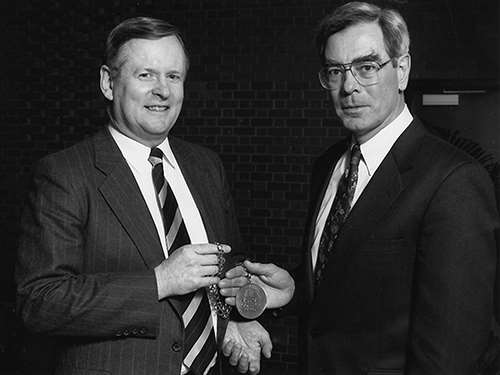 I had known Dr. Dunn when he was a student at Marquette…he was a senior and I was a freshman. He was president of the Liberal Arts Council, and I was impressed with his demeanor. I became president of the student body when he was in medical school and also a representative to the student body. So I knew him, and always was impressed with him. I hired him because he was a leader; his style of leadership melded perfectly with mine. We shared a vision about the importance of research and he worked with me to build the research infrastructure.
I had known Dr. Dunn when he was a student at Marquette…he was a senior and I was a freshman. He was president of the Liberal Arts Council, and I was impressed with his demeanor. I became president of the student body when he was in medical school and also a representative to the student body. So I knew him, and always was impressed with him. I hired him because he was a leader; his style of leadership melded perfectly with mine. We shared a vision about the importance of research and he worked with me to build the research infrastructure.
1995: Creation of the Graduate School of Biomedical Sciences
That same year, nearly 60 years after the Marquette University School of Medicine conferred its first non-MD graduate degrees from clinical departments, under Mike’s leadership the MCW board of trustees formally established the Graduate School of Biomedical Sciences as a distinct academic school. Currently, the Graduate School provides 22 PhD, master’s and certificate programs in six academic disciplines and boasts more than 400 scientists in training each year.
Creating the Graduate School of Biomedical Sciences was part of our efforts to enhance research. Most research is undertaken by PhDs, and I wanted to have a school of graduate studies whereby a PhD from MCW meant something. This also helped us to procure significant grants.
Enhancing the education mission
Mike believed that at the core of the practice of medicine was a mission of caring for the sick and vulnerable, and he wove that core tenet of careful medicine into the fabric of the administration and education at MCW. During Mike’s tenure, 34 academic department chairs were recruited to MCW, including Paula Traktman, PhD, the first female chair of what is now the department of microbiology and immunology. Additionally, MCW faculty physicians grew from 400 doctors in 1990 to 1,100 physicians in 2010 – reflecting the institution’s strong collaborations with area hospitals and healthcare entities.
The medical school is lucky to have the Zablocki VA, Froedtert and Children’s as teaching hospital partners, as well as the BloodCenter of Wisconsin and a good working relationship with Curative Care.
Building the education pipeline
Mike was dedicated to building the pipeline of qualified minority applicants to MCW’s medical and graduate schools, and in 2000 spearheaded a major community initiative to address the significant gap in minority achievement in the health sciences. The result was the establishment of the Milwaukee Academy of Science – which at that time opened as a K-8 school on the site of the old Milwaukee / Lutheran / Good Samaritan Hospital at 20th Street and Kilbourn Avenue. In 2007, the school expanded to K4-12, allowing it serve more than 1,000 students on the campus. Now, nearly 20 years later, the Milwaukee Academy of Science continues to carry out Mike’s vision for equity, learning and excellence in the health sciences, and is a model in STEM education enabling urban students to be prepared to compete successfully at the post-secondary level.
I called our registrar, Lesley Mack, and asked how many of our students come from Milwaukee Public Schools (MPS). She looked at the last 1,000 matriculants and said that only 13 had come from MPS. I told her that we were failing our inner city children in math and science. So I met with Mayor John Norquist and asked him to do something about it. He then asked me, “What are you going to do about it?” He then said, “If you really want to increase our students’ depth of knowledge in math and science, why don’t you start a charter school?” I told him I ran a medical school and didn’t know anything about running a charter school. So he told me to talk with Howard Fuller, who was had been the superintendent of MPS. We met with him and a larger group and put together a plan for a charter school – and now our students are going on to college and even applying to medical school.
Strengthening MCW’s finances and governance
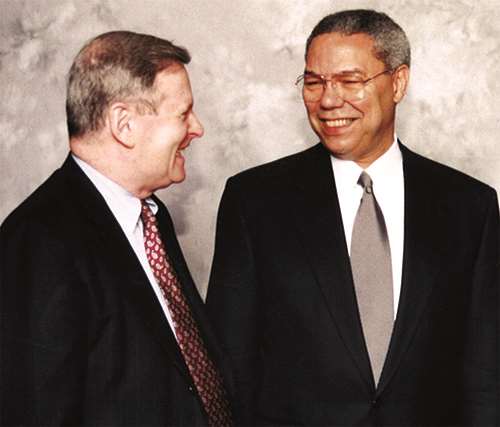 Mike was committed to strengthening MCW’s financial position to ensure the institution’s long-term viability and to provide adequate resources for growth. A tireless fundraiser (or “friend-raiser,” as he liked to refer to himself), during his tenure Mike significantly increased MCW’s endowment and the institution received more than $240 million in private donations.
Mike was committed to strengthening MCW’s financial position to ensure the institution’s long-term viability and to provide adequate resources for growth. A tireless fundraiser (or “friend-raiser,” as he liked to refer to himself), during his tenure Mike significantly increased MCW’s endowment and the institution received more than $240 million in private donations.
The board wanted to make sure we didn’t run out of money, so we took a long hard look at our finances since the institution was on shaky ground when I took the position. They wanted me to raise money because the philanthropic effort was not very robust. I had raised a lot of money in the community for causes such as United Performing Arts Fund, United Way and various schools and charities. I didn’t have any qualms about asking for money. I created the Office of Institutional Advancement to maintain fundraising as a year-round event. I engineered a capital campaign and we built our infrastructure for “friend-raising.” I always said that if you get their hearts and minds first, their wallets will follow. It was hard work, and a long-term process. We hired some good people, and the money began to grow. I always called this our “margin of excellence,” which helped to fund our research enterprise and eventually gave our school panache.
(Pictured right: Mike Bolger welcomes General Colin Powell (Ret.) as the keynote speaker at MCW's Healthcare Dinner in 1996.)
In addition to maintaining a strong financial position, Mike believed that strong governance at the top was critical to MCW’s long-term success – and that diversity among board members was critical. During his tenure, Mike helped recruit 73 trustees to MCW’s board.
I deliberately set out to make the MCW board the strongest board in the community. I was told that in Milwaukee I would need the big three: Johnson Controls, Northwestern Mutual and Wisconsin Energy (We Energies). If you had those three, you could get anyone on the board. And so I got them. Then we got the president/CEO of M & I Bank, and other movers and shakers. I wanted to create diversity on the board, so the first woman I put on the board was Linda Mellowes. I also put individuals of color on the board, including John Daniels, who was the first African American lawyer at Quarles & Brady, whom I had hired. I still think it’s one of the best boards in town. These people can open doors for you all over town. Building that board was a lot of fun.
The power of philanthropy
Raising funds for endowed chairs was a particular passion of Mike’s. “Mike always said that a major goal of his was to create 20 endowed chairs in 20 years,” Ginny shares. Not surprisingly, Mike achieved 150% of that goal, with 30 endowed chairs funded from 1990-2010. The most significant of these was $10 million received from Dr. Robert D. Kern and Dr. Patricia E. Kern in 1999 to establish a named professorship in biotechnology and bioengineering and for overall support of biomedical research, education and collaboration through a new Biotechnology Innovation Center; at the time it was the largest single private gift ever to MCW. Mike’s close long-term relationship with the Kerns laid the groundwork for future efforts by MCW president and CEO John R. Raymond, MD, to secure a $37.8 million gift from the Kern Family and the Kern Family Foundation in 2017 to create the Kern Institute for the Transformation of Medical Education and the National Transformation Network.
Faculty love to hold endowed chairs…it’s a matter of prestige. I felt it was very important to build the endowment for endowed chairs, which was very small at the time. We were able to create endowed chairs in almost every field over the years. People who don’t like endowments don’t have a long-term view, but I thought about what they would be worth 100 years from now.
Building healthier communities
Under Mike’s leadership, community service became the fourth mission of the institution (along with education, research and patient care). A major milestone in MCW’s evolution as a leader in building healthier communities was MCW’s receipt of more than $300 million from the 1999 conversion of Blue Cross & Blue Shield United of Wisconsin from a nonprofit company to a for-profit stock corporation. This conversion led to the creation in 2004 of MCW’s Advancing a Healthier Wisconsin Endowment, which has enabled MCW to commit more than $250 million to support more than 400 education, research and academic/community partnership projects throughout Wisconsin, engaging hundreds of community organizations.
The Blue Cross/Blue Shield gift was a result of luck and preparation. We had asked them for $100,000 for the capital campaign and then learned that they were converting from not-for-profit to for-profit status – and that they were thinking of donating the net worth of the company to the two medical schools in the state. So I thought perhaps we would get a million dollars – but in actuality it was a $300 million gift. I spent an entire summer going around the state participating in listening sessions to discuss what we intended to do with the funds – which was creating healthcare programs to benefit the public.
Mike was an extremely successful president for 20 years. We owe him a debt of gratitude.
Michael J. Dunn, MD, MCW dean, 1995-2008
Mike has and will continue to enrich our lives and enhance our community. How fortunate I was to know him as a mentor, a teacher and a friend.
Lesley A. Mack, 40-year MCW employee (retired in 2016 as MCW registrar)
Read more about the remarkable life and legacy of T. Michael Bolger (1939-2018), the longest-serving president and CEO of the Medical College of Wisconsin.
-
We Remember a Visionary: The Legacy of T. Michael Bolger – Part One
The first installment in a three-part series featured in the Spring 2019 issue of the MCW Magazine. -
We Remember a Visionary: The Legacy of T. Michael Bolger – Part Three
The third installment in a three-part series featured in the Spring 2019 issue of the MCW Magazine.



